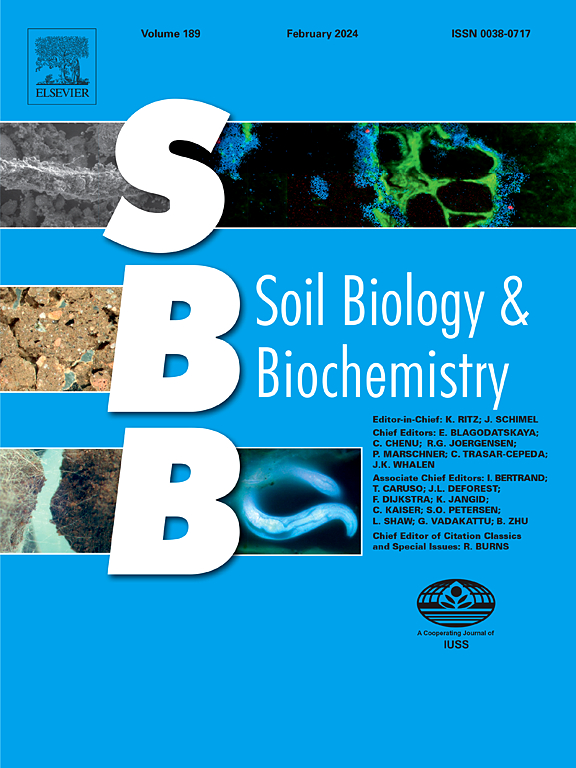Depth-dependent dynamics of microarthropods in forest floors along temperature and soil phosphorus gradients
IF 9.8
1区 农林科学
Q1 SOIL SCIENCE
引用次数: 0
Abstract
Forest floors buffer harsh environmental conditions and insulate soil, thereby mitigating the effect of climate extremes on soil fauna. Conversely, the soil fauna is key for shaping the structure of forest floors. We investigated the distribution patterns of two major decomposer microarthropod groups (Collembola and Oribatida) across the different layers of the forest floor (Ol, Of/Oh) and the upper mineral soil (Ah) of 12 forest sites representing temperature and phosphorus gradients. A total of 58 Collembola and 144 Oribatida species were recorded. Phosphorus as main factor neither significantly affected the abundance of Collembola nor that of Oribatida. Oribatida richness significantly increased with increasing temperature but decreased with increasing phosphorus level. The abundance, richness and biomass of both microarthropod groups were at a maximum in the Of/Oh layer followed by the Ah and Ol layer. Collembola and Oribatida community structure also varied with temperature and phosphorus levels but this depended on layer. We identified soil and litter carbon-to-nitrogen ratio, pH, Gram-positive bacterial phospholipid fatty acids (PLFAs) and thickness of Ol and Of/Oh layers as important drivers for Collembola and Oribatida communities. These findings highlight the critical influence of temperature, phosphorus and forest floor stratification on soil microarthropod communities, alongside additional other soil properties. The differential responses of Collembola and Oribatida to temperature and phosphorus gradients underscore functional and ecological differences between these groups, with Oribatida being more sensitive to climatic and nutrient changes. Overall, the results emphasize the importance of maintaining the structural integrity of forest floors to support diverse and resilient soil fauna communities.森林地面微节肢动物沿温度和土壤磷梯度的深度依赖动态
森林地面缓冲了恶劣的环境条件,隔绝了土壤,从而减轻了极端气候对土壤动物的影响。相反,土壤动物是形成森林地面结构的关键。研究了12个具有温度和磷梯度的森林样地不同层(Ol、of /Oh)和上部矿质土(Ah)中两种主要分解者微节肢动物类群(Collembola和Oribatida)的分布格局。共记录弹虫58种,甲虫144种。磷作为主要因子对弹虫和甲虫的丰度影响不显著。甲虫丰富度随温度升高而显著增加,但随磷水平升高而降低。两类微节肢动物的丰度、丰富度和生物量均在of /Oh层最大,其次是Ah和Ol层。弹虫和鳞虫群落结构也随温度和磷水平的变化而变化,但这取决于层数。我们发现土壤和凋落物的碳氮比、pH、革兰氏阳性细菌磷脂脂肪酸(PLFAs)以及Ol和of /Oh层的厚度是线虫和鳞虫群落的重要驱动因素。这些发现强调了温度、磷和森林地面分层对土壤微节肢动物群落的关键影响,以及其他土壤特性。弹尾虫和甲尾虫对温度和磷梯度的不同响应强调了这两个类群之间的功能和生态差异,甲尾虫对气候和养分变化更为敏感。总体而言,研究结果强调了保持森林地面结构完整性对支持多样化和有弹性的土壤动物群落的重要性。
本文章由计算机程序翻译,如有差异,请以英文原文为准。
求助全文
约1分钟内获得全文
求助全文
来源期刊

Soil Biology & Biochemistry
农林科学-土壤科学
CiteScore
16.90
自引率
9.30%
发文量
312
审稿时长
49 days
期刊介绍:
Soil Biology & Biochemistry publishes original research articles of international significance focusing on biological processes in soil and their applications to soil and environmental quality. Major topics include the ecology and biochemical processes of soil organisms, their effects on the environment, and interactions with plants. The journal also welcomes state-of-the-art reviews and discussions on contemporary research in soil biology and biochemistry.
 求助内容:
求助内容: 应助结果提醒方式:
应助结果提醒方式:


